By Sean Mooney
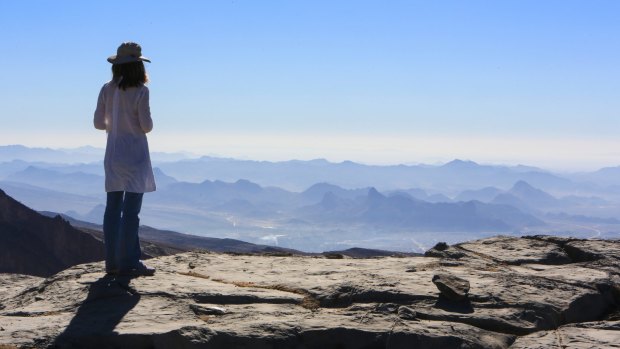
Jebel Shams, or Mountain of the Sun (3009 metres) is Oman's highest mountain, famous for the spectacularly deep Wadi Ghul lying alongside.
Standing on a peak almost three kilometres above sea level, looking out over a canyon that could only be described as grand, my wife, daughter, son and I are surprised to hear the plaintive cry of a goat.
It's not that the sound is uncommon in this part of the world; huge numbers of these sure-footed ruminants roam the highlands of the Arabian Peninsula. The perplexing part is that it's coming from above us, and we're all relatively confident that goats, like pigs, can't fly. We look up and, sure enough, there's a horned beast, all reddish-brown matted wool, glaring down at us with devilish eyes. It's straddling the branches of a thorny tree, the canopy of which extends over the precipice. We take a few steps back from the edge, just in case the goat falls and knocks us all into the ravine. That would be, we all agree, a particularly dumb way to die.
Almost as hard to fathom as flying goats is the fact that only a couple of hours ago we were driving across a barren plain with the mercury nudging 45 degrees. Now that we've successfully negotiated countless slopes and switchbacks to reach the top of Jebel Shams – Mountain of the Sun – it's only 18 degrees, with a stiff breeze and the thin mountain air making it feel even cooler.
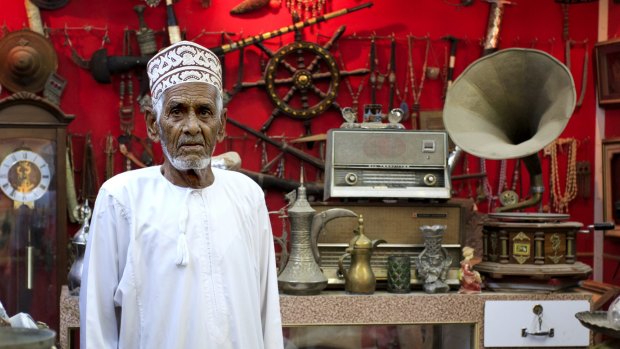
An antique dealer in Muttrah Souk.
The next day we'll be sandboarding in a desert of red, rolling dunes, and the day after that watching turtles lay eggs on the edge of the Indian Ocean. We've already cycled through remote highland villages, hiked to 5000-year-old stone tombs and feasted on fat, ruddy pomegranates fresh off the tree. But that's the Sultanate of Oman for you; it defies the misconceptions of those who imagine it to be a land of sand and oil and more sand … if they've even heard of the place at all. And it offers many welcome surprises for the family open-minded enough to holiday there.
For many of us, the shiny desert metropolis of Dubai is our one and only taste of the Gulf, often experienced as a quick stopover offering an excess of everything – the tallest building in the world, the biggest mall, mind-blowing aquariums, even an indoor ski slope. It's great fun and my family loves it.
But less than an hour's flight away, Oman offers a completely different taste of a region that people often overlook, perhaps thinking that the rest of the Arabian Peninsula is all about Yemen and Saudi Arabia – not exactly family-friendly destinations at the best of times.
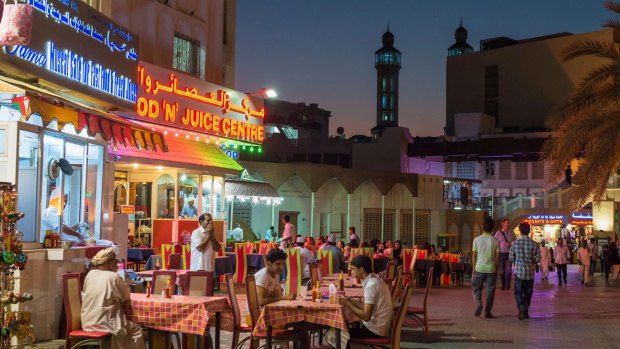
The restaurants in front of Muttrah souq.Credit: Alamy
That's a shame, because from the rocky peaks and fiords in the north, through the great eastern sea of sand dunes, down to the southern monsoonal mountains, Oman's varied landscape makes for an unforgettable family road trip.
Full disclosure: My wife Jo and I lived and worked in Oman in the early noughties after I applied for a job as a magazine editor. I soon found myself being paid to travel the length and breadth of the country and write about it for locals, expats and tourists. We had many amazing and unforgettable experiences, so when we returned to Australia to start a family, we agreed that one day we would go back to Oman with our kids.
Which is how we find ourselves on top of the highest peak of Arabia, keeping one eye on a tree-top goat while watching the canyon walls turn red, then purple, then leaden as night falls. Our holiday also started with mountains, albeit the much smaller ones that surround the country's coastal capital of Muscat.
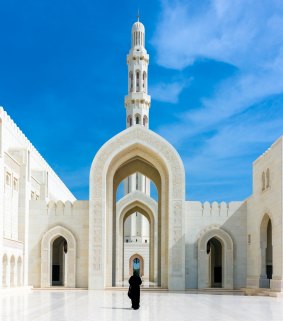
The Sultan Qaboos Grand Mosque in Muscat.
Unlike Dubai, it hasn't succumbed to the siren song of steel and glass. Set against a dramatic backdrop of bare, jagged rock, the old port of Muscat is where the country's ruler, Sultan Qaboos bin Said, has his main palace. It is still surrounded by the old city walls and flanked by forts that date to the 16th century, making the old town look and feel like something out of an Arabian fairytale.
The nearby harbourside commercial centre of Muttrah is where the city's best evening action can always be found. Omani men stroll along the corniche in immaculate long dress shirts known as dishdashas, the women in long dresses and colourful head scarves. Oman's resident communities of Bangladeshis, Filipinos, Indians, Pakistanis and Sri Lankans are also impossible to miss, as they make up almost half of Oman's population of more than 4 million. The restaurants in front of Muttrah souq, or market, are perfect for watching this exotic parade. Children, in particular, love the multilayered mixed juices on the menu here; they are the perfect accompaniment to the grilled meat and falafel served with hummus and high-octane garlic sauce.
The tight and winding network of little laneways that make up the souq itself is a delight, with its sensory overload of perfumes, spices, jewellery, antiques, clothes and food. It's an extremely safe and fun experience for families without too much of the hard sell found in many Middle Eastern marketplaces. But be warned: your kids will probably want one of the ornate daggers (khanjar) or antique rifles that cover the walls of several shops. Just remember the useful parental refrain, "they won't let us back into the country with that".
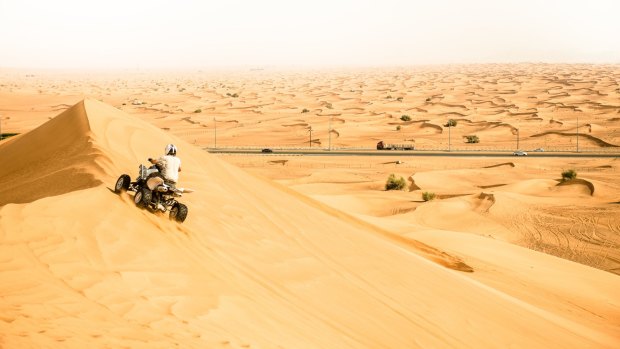
Riding across the dunes on a quad bike, Hatta, Oman.
A similarly atmospheric souq can be found in the inland town of Nizwa just a few hours' drive from Muscat. The chaotic livestock auctions held on Friday mornings are in themselves worth the trip. This regional centre also serves as a great base from which to visit surrounding attractions such as 17th-century Jabrin Fort; it's well preserved and has the added benefit of housing hundreds of miniature bats that delight and terrify kids in equal measure. The nearby historic fort and walled town of Bahla is a World Heritage site that dates to the third millennium BC. Also heritage-listed are thousands of cylindrical rock tombs scattered over the country, many of which date back more than 5000 years to when Oman was a major producer of copper, wood and frankincense. Experiencing sunset among some of the best preserved "beehive" tombs in this region, while the call to prayer echoes through the mountains, is an unforgettable experience.
These sites are in the foothills of Jebel Shams and its slightly smaller but more verdant neighbour, Jebel Akhdar (Green Mountain). The latter is appropriately named, as it is the country's cool climate agriculture hub. Much of this is carried out in mountainside terraces that, while common in neighbouring Yemen, are unique in Oman. Rosewater and honey are two of the most famous products of the highlands, but locals working the terraces will sell visitors whatever produce is in season, with apricots, peaches, figs, apples, grapes, pears, plums, walnuts and almonds all available at various times. My family thought it was hilarious watching me haggle for pomegranates in dodgy Arabic with a wizened, toothless farmer.
Jebel Akhdar Alila Resort and Spa, with its cliff-side infinity pool and environmentally sympathetic stone and wood architecture, is a family-friendly delight. Cycling out from the property to visit nearby abandoned and seasonal herding settlements is great fun, the lower temperatures at altitude make this a comfortable, if literally breathtaking, activity.
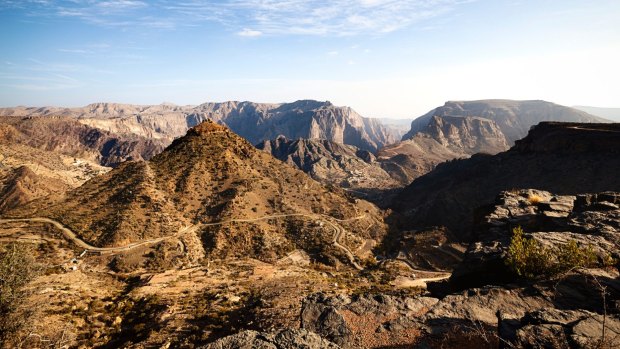
Jebel Akhdar (Green Mountain), Oman.
Hotter, sandier adventures can be found a few hours' drive to the east. The tourist camps on the edge of the great Sharqiya Sands desert are a must for anyone with kids, as they all offer dune drives, sandboarding, tobogganing and camel rides, among other activities. Sunrises and sunsets among the dunes are highlights, of course, as is simply gazing up at the star-filled sky. The more luxurious camps have airconditioning, running water and fridges in all tents, so there's no need to rough it. You will find, however, that much of the sand will find its way home in your clothes and suitcases.
This desert covers much of the country's east, and the sand dunes roll all the way into the Indian Ocean near the eastern tip of Arabia. It is a particularly important nesting zone for turtles that travel there from as far away as the coast of Somalia. The Ras al-Jinz Turtle Reserve offers average accommodation (think Soviet architecture meets public service hospitality), but it's worth staying for a night to secure spots on the guided evening and (very) early morning tours of the two main nesting beaches. In peak season (July to October), visitors will almost always see turtles dragging themselves up the beach, digging nests and laying eggs in the sand. The lucky ones will even witness freshly hatched baby turtles dodging crabs, seagulls and foxes to reach the ocean.
Sealife spotting is also on the cards on the Musandam Peninsula, Oman's small northern foothold on the edge of the world's main oil-supply waterway, the Strait of Hormuz. Traditional wooden boats known as dhows take passengers dolphin-spotting from the port town of Khasab. The cruises visit inlets once used for shelter by pirates; their modern-day equivalents – sanction-busting smugglers – fill their open-topped speedboats nearby with electronic goods, pharmaceuticals, motorcycles and American cigarettes, then run a gauntlet of oil tankers and coastguard patrols to make the 60-kilometre crossing to Iran.
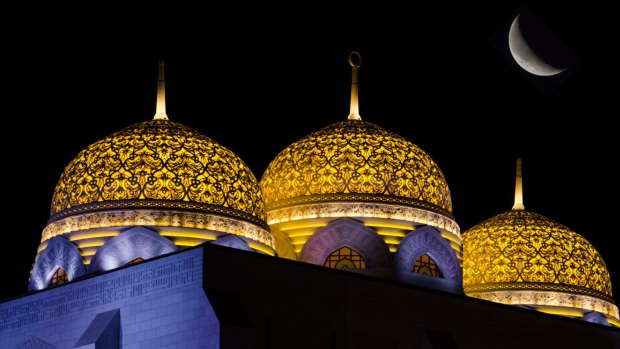
The Mohammed Al Ameen Grand Mosque in Muscat.
One of the highlights of these cruises is lunch and snorkelling at Telegraph Island, which served as a base for Britons laying the first submarine telegraph cable in the region in the mid 19th century. The expression "going round the bend" reputedly comes from this period when the cable was being directed through the Gulf's geographical kink. Most parents on holiday with their kids will have moments when they can totally relate to this sentiment. Happily, the variety of attractions and experiences open to families travelling in Oman leaves little room for boredom, keeping tears, tantrums and even teenager sulks to a minimum.
Sean Mooney and his family paid their own way for this journey.
FIVE MORE THINGS TO DO WITH A FAMILY IN OMAN
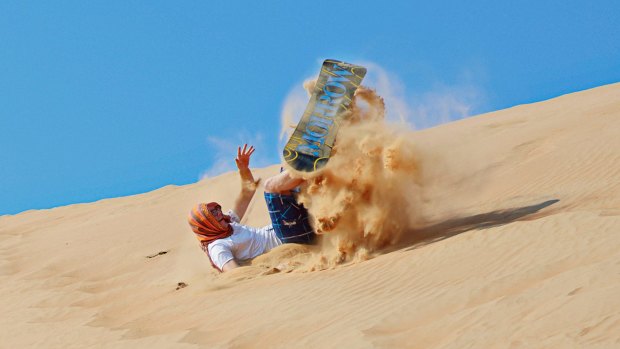
Sandboarding at Wahiba Sands.Credit: Alamy
MAKING FOR THE MOSQUE
The Sultan Qaboos Grand Mosque in Muscat is quite simply one of the world's largest and most expensive places of worship. The complex is made of cream and lilac sandstone with marble tiles. Major features of the mosque's interior are the enormous handmade Persian carpet and similarly large chandelier in the main prayer hall.
EATING LOCAL
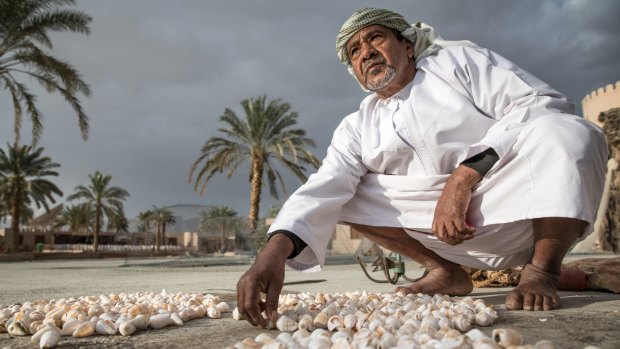
An Omani man laying out sea shells.
Track down an Omani eatery for some shwarba, a wheat soup with meat, and sahana, a kind of porridge made from rice flour and milk. Omani halva is often flavoured with saffron, cardamom, nuts and rosewater and can be bought at the souq.
RUNNING ON EMPTY
The Rub al Khali (The Empty Quarter), a great dune desert the size of France, covers much of Oman. It was through this sandy wasteland that camel caravans once plied frankincense from the Hadramaut Kingdoms of Southern Arabia, onwards to Egypt, Palestine, Rome and beyond. An experienced guide can lead you in and, more importantly, lead you out again.
GOING FOR GREEN
Oman's second city, Salalah, is the capital of Dhofar, the southern province of Oman. A monsoonal season between May and September covers the region's hills in lush greenery that is unlike anywhere else in Arabia. It also has prehistoric rock art and, incredibly, flamingos.
HANGING WITH HERITAGE
Oman has no less than four UNESCO World Heritage Sites: Bahla Fort, a series of al-falaj irrigation systems, the Al-Ayn, Al-Khutm and Bat settlements and necropolises, and several locations that were integral to the ancient frankincense trade. All are worth visiting.
MORE INFORMATION
GETTING THERE
Emirates and Qantas fly 13 times a day from Dubai to Australia, and Emirates flies from Dubai to Muscat daily. Phone 1300 303 777. See emirates.com
STAYING THERE
Shangri-La's Barr Al Jissah Resort and Spa
shangri-la.com/muscat/barraljissahresort
Jebel Akhdar Alila Resort & Spa
Desert Nights Camp
GETTING AROUND
You can rent a four-wheel-drive from one of the many car hire companies in Muscat for a self-drive road trip. If you do, ensure you have up-to-date maps and/or GPS navigation. Otherwise, hire a guide as part of a planned itinerary booked through Tourism Oman.
WHEN TO GO
Oman is best visited in the cooler months (October to April), as summer temperatures can be quite extreme. November to February is when it's most comfortable, although it can get cold in the mountains at night.
Sign up for the Traveller Deals newsletter
Get exclusive travel deals delivered straight to your inbox. Sign up now.